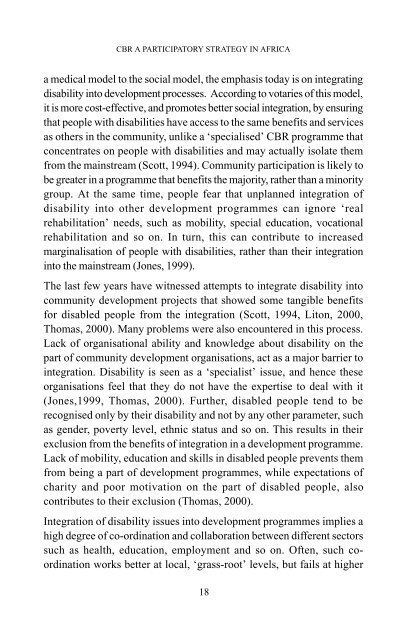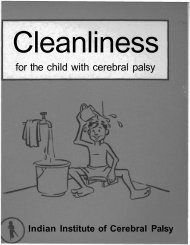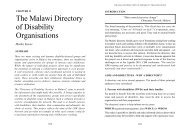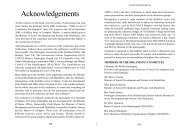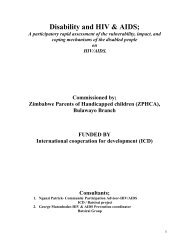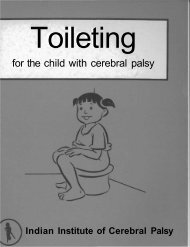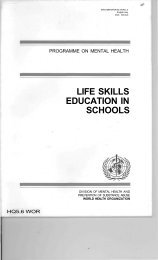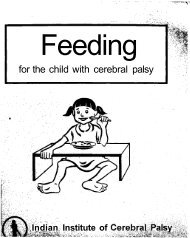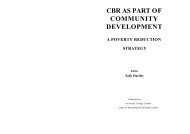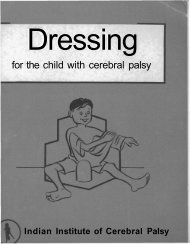Some Controversies in Community Based Rehabilitation - Source
Some Controversies in Community Based Rehabilitation - Source
Some Controversies in Community Based Rehabilitation - Source
Create successful ePaper yourself
Turn your PDF publications into a flip-book with our unique Google optimized e-Paper software.
CBR A PARTICIPATORY STRATEGY IN AFRICA<br />
a medical model to the social model, the emphasis today is on <strong>in</strong>tegrat<strong>in</strong>g<br />
disability <strong>in</strong>to development processes. Accord<strong>in</strong>g to votaries of this model,<br />
it is more cost-effective, and promotes better social <strong>in</strong>tegration, by ensur<strong>in</strong>g<br />
that people with disabilities have access to the same benefits and services<br />
as others <strong>in</strong> the community, unlike a ‘specialised’ CBR programme that<br />
concentrates on people with disabilities and may actually isolate them<br />
from the ma<strong>in</strong>stream (Scott, 1994). <strong>Community</strong> participation is likely to<br />
be greater <strong>in</strong> a programme that benefits the majority, rather than a m<strong>in</strong>ority<br />
group. At the same time, people fear that unplanned <strong>in</strong>tegration of<br />
disability <strong>in</strong>to other development programmes can ignore ‘real<br />
rehabilitation’ needs, such as mobility, special education, vocational<br />
rehabilitation and so on. In turn, this can contribute to <strong>in</strong>creased<br />
marg<strong>in</strong>alisation of people with disabilities, rather than their <strong>in</strong>tegration<br />
<strong>in</strong>to the ma<strong>in</strong>stream (Jones, 1999).<br />
The last few years have witnessed attempts to <strong>in</strong>tegrate disability <strong>in</strong>to<br />
community development projects that showed some tangible benefits<br />
for disabled people from the <strong>in</strong>tegration (Scott, 1994, Liton, 2000,<br />
Thomas, 2000). Many problems were also encountered <strong>in</strong> this process.<br />
Lack of organisational ability and knowledge about disability on the<br />
part of community development organisations, act as a major barrier to<br />
<strong>in</strong>tegration. Disability is seen as a ‘specialist’ issue, and hence these<br />
organisations feel that they do not have the expertise to deal with it<br />
(Jones,1999, Thomas, 2000). Further, disabled people tend to be<br />
recognised only by their disability and not by any other parameter, such<br />
as gender, poverty level, ethnic status and so on. This results <strong>in</strong> their<br />
exclusion from the benefits of <strong>in</strong>tegration <strong>in</strong> a development programme.<br />
Lack of mobility, education and skills <strong>in</strong> disabled people prevents them<br />
from be<strong>in</strong>g a part of development programmes, while expectations of<br />
charity and poor motivation on the part of disabled people, also<br />
contributes to their exclusion (Thomas, 2000).<br />
Integration of disability issues <strong>in</strong>to development programmes implies a<br />
high degree of co-ord<strong>in</strong>ation and collaboration between different sectors<br />
such as health, education, employment and so on. Often, such coord<strong>in</strong>ation<br />
works better at local, ‘grass-root’ levels, but fails at higher<br />
18


